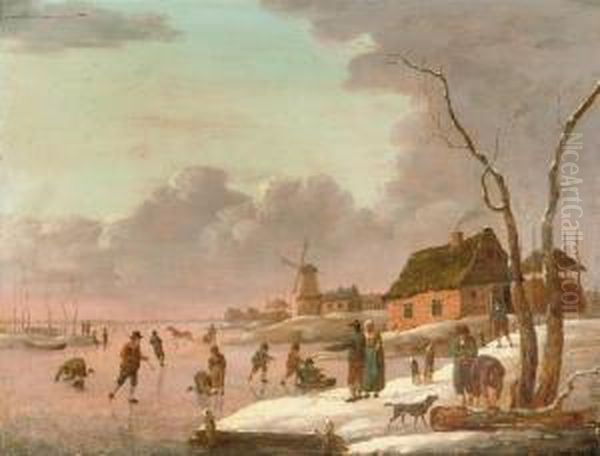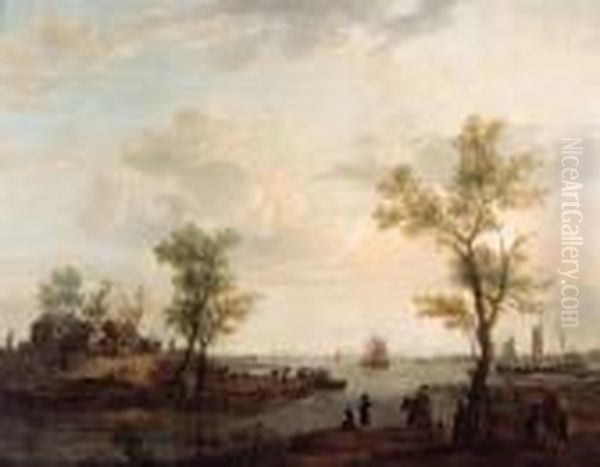Heinrich Wilhelm Schweickhardt stands as a notable figure in late 18th-century European art, a German-born painter who masterfully adopted and perpetuated the traditions of Dutch Golden Age landscape and genre painting. Active primarily in the Netherlands and later in England, Schweickhardt carved a niche for himself with his evocative winter scenes, pastoral landscapes, and lively depictions of everyday life, leaving behind a body of work that bridges the late Baroque sensibility with the nascent stirrings of Romanticism.
Early Life and Artistic Genesis in The Hague
Born in Brandenburg, Prussia, in 1746, Heinrich Wilhelm Schweickhardt's artistic journey began not in his homeland but in the Netherlands, a country whose artistic legacy would profoundly shape his own. It is believed he was of Dutch descent, which might explain his early affinity for the region's artistic traditions. His formal training took place in The Hague, a vibrant artistic center. There, he studied under Girolamo Lapis (1723-1798), an Italian painter who had settled in the city. Lapis, though Italian, was well-versed in the prevailing tastes, and his tutelage would have exposed Schweickhardt to a variety of styles, though the Dutch influence clearly became paramount.
The Hague provided a fertile environment for the young artist. The city still basked in the reflected glory of its 17th-century masters, and there was a continuing demand for paintings in their style. Schweickhardt quickly absorbed the techniques and thematic concerns of artists like Aert van der Neer (1603-1677), renowned for his moonlit and winter landscapes, and Isaack van Ostade (1621-1649), whose bustling winter scenes filled with skaters and villagers found a clear echo in Schweickhardt's later work. He also likely studied the works of animal painters such as Paulus Potter (1625-1654) and Adriaen van de Velde (1636-1672), whose meticulous renderings of livestock in pastoral settings informed Schweickhardt's own depictions of animals.

During his time in The Hague, Schweickhardt established himself as a capable painter, catering to the tastes of both the court and the affluent bourgeoisie. He produced not only landscapes but also portraits and genre scenes, often featuring peasants, fishermen, and, notably, animals, which he rendered with considerable skill. His works from this period demonstrate a keen observational ability and a developing command of atmospheric effects, a hallmark of Dutch landscape painting.
Relocation to London and Mature Career
In 1786, seeking new opportunities or perhaps a broader audience, Schweickhardt made a significant move to London. England at this time had a burgeoning art market and a growing appreciation for landscape painting, influenced by both its native sons like Thomas Gainsborough (1727-1788) and Richard Wilson (1714-1782), and by the continued importation of Dutch Old Masters. Schweickhardt's Dutch-inflected style found a receptive audience in Britain.
It was in London that Schweickhardt's reputation, particularly for winter landscapes, solidified. He spent nearly a decade in the city, from 1786 until his death in 1797. His winter scenes from this period are particularly celebrated. These compositions often feature frozen canals and rivers, populated by figures skating, sledding, or going about their winter chores. He employed a cool palette, dominated by blues, greys, and whites, accented with the warmer tones of brick buildings or figures' clothing, creating a palpable sense of crisp, cold air. The influence of 17th-century Dutch masters like Hendrick Avercamp (1585-1634) is undeniable in these works, yet Schweickhardt imbued them with his own distinct, slightly softer, 18th-century sensibility.
Beyond oil paintings, Schweickhardt was also an accomplished engraver. He produced numerous etchings, often depicting animals or rural scenes, sometimes drawing inspiration from earlier masters but always with his own touch. These prints helped to disseminate his imagery more widely and contributed to his contemporary reputation. His works were exhibited, and he gained a measure of recognition within the London art scene.
Artistic Style, Techniques, and Thematic Preferences
Heinrich Wilhelm Schweickhardt's artistic style is firmly rooted in the Dutch tradition of the 17th century, yet it is filtered through an 18th-century lens. His primary allegiance was to naturalism, aiming to capture the observable world with accuracy, particularly in terms of light and atmosphere.

Landscape Painting: This was Schweickhardt's forte. His landscapes, whether summer or winter, typically feature a low horizon line, allowing for expansive skies that dominate the composition – a characteristic trait of Dutch masters like Jan van Goyen (1596-1656) and Salomon van Ruysdael (1596-1656). He paid close attention to cloud formations and the quality of light, adeptly conveying different times of day and weather conditions. His summer landscapes often depict pastoral scenes with rolling hills, placid rivers, and carefully rendered trees, frequently populated with cattle or sheep, recalling the work of artists like Nicolaes Berchem (1620-1683) in their idyllic mood, though Schweickhardt's settings are typically more Northern European than Italianate.
Winter Scenes: Schweickhardt is perhaps best known for his winter landscapes. These works capture the stark beauty and communal activities of the season. He excelled at rendering the texture of ice and snow, the bare branches of trees, and the rosy cheeks of figures braving the cold. The compositions are often animated with numerous small figures engaged in various activities, providing narrative interest and a sense of lively community. The careful arrangement of these figures, often leading the eye into the distance, demonstrates a sophisticated understanding of spatial recession.
Genre Elements: Many of Schweickhardt's landscapes incorporate strong genre elements. The figures are not mere staffage but integral parts of the scene, depicting everyday life. Whether it's peasants conversing, fishermen tending their nets, or families enjoying a winter outing, these human touches add warmth and relatability to his paintings. This focus on the everyday connects him to the broader tradition of Dutch genre painters like Adriaen van Ostade (1610-1685).
Use of Color and Light: Schweickhardt's palette was generally subdued and naturalistic, favoring earthy tones, soft greens, and atmospheric blues and greys. In his winter scenes, as mentioned, cool colors predominate, but he skillfully used touches of warmer color to create focal points and prevent monotony. His handling of light was crucial for creating mood, whether it was the diffuse light of an overcast day, the crisp clarity of a winter afternoon, or the gentle glow of a summer evening.
Brushwork and Detail: His technique involved relatively smooth brushwork, allowing for a good degree of detail without becoming overly meticulous or photographic. He balanced descriptive accuracy with a painterly quality, ensuring that his works retained a sense of artistic interpretation rather than mere transcription.
Notable Works: "Winter Landscape" (Paisaje de Invierno)
Among Schweickhardt's most representative and celebrated works is Paisaje de invierno (Winter Landscape), dated to around 1775 and now housed in the Museo Nacional de Bellas Artes in Buenos Aires, Argentina. This painting encapsulates many of the defining characteristics of his style.
The composition adheres to the Dutch tradition with a low horizon, dedicating a significant portion of the canvas to a luminous, cloud-streaked sky. The foreground and middle ground depict a frozen waterway bustling with activity. Figures skate with varying degrees of skill, some glide gracefully while others appear more tentative. A horse-drawn sleigh makes its way across the ice, and groups of people converse or watch the skaters. Architectural elements, including rustic houses, a bridge, and wooden fences, are carefully integrated into the landscape, providing structure and a sense of place.
The color palette is predominantly cool, with blues, greys, and whites conveying the icy atmosphere. However, Schweickhardt masterfully introduces warmer accents – the ochres and reddish-browns of the buildings, the varied colors of the figures' attire – which enliven the scene and prevent it from feeling desolate. The light is that of a clear winter day, casting subtle shadows and highlighting the textures of snow and ice.
The painting is a testament to Schweickhardt's skill in creating a cohesive and engaging scene, filled with anecdotal detail yet unified by a consistent atmospheric mood. It demonstrates his debt to 17th-century Dutch winter scenes while also possessing a slightly more delicate, Rococo-influenced charm in the depiction of the figures, characteristic of the later 18th century.
Influence and Art Historical Position
Heinrich Wilhelm Schweickhardt occupied an interesting position in the art history of the late 18th century. He was a skilled practitioner of an established tradition, the Dutch landscape and genre style, at a time when new artistic currents, particularly Neoclassicism and early Romanticism, were gaining momentum.
His direct influence can be seen in the work of some early 19th-century painters who continued the tradition of Dutch-inspired landscape painting. Notably, artists like Andreas Schelfhout (1787-1870) and Charles Leickert (1816-1907), both of whom became highly successful painters of winter scenes and other Dutch landscapes in the Romantic era, can be seen as inheritors of the tradition that Schweickhardt helped to sustain and transmit. While they developed their own distinct styles, the thematic concerns and compositional approaches found in Schweickhardt's work provided a foundation.
Schweickhardt's dedication to capturing atmospheric effects and the specific character of a landscape, particularly in his winter scenes, also aligns with the broader shift towards a more emotive and experiential approach to nature that characterized the Romantic movement. Though not a Romantic painter in the dramatic or sublime vein of artists like Caspar David Friedrich (1774-1840) or J.M.W. Turner (1775-1851), Schweickhardt's sensitive rendering of natural phenomena contributed to the ongoing appreciation and development of landscape art.
His work also serves as a reminder of the enduring appeal of Dutch Golden Age art throughout the 18th and 19th centuries. Collectors continued to prize 17th-century Dutch paintings, and artists like Schweickhardt catered to this taste, ensuring the vitality of the tradition. He was part of a lineage of artists, including figures like Jacob van Strij (1756-1815) in the Netherlands, who looked back to the Golden Age for inspiration while working within their contemporary context.
It is also important to distinguish Heinrich Wilhelm Schweickhardt, the painter, from his near-contemporary, the renowned German Renaissance architect Heinrich Schickhardt (1558-1635). The architect was a much earlier figure, celebrated for his work in Württemberg, and there is no direct artistic connection between the two beyond the similarity in name which can occasionally cause confusion.
Schweickhardt's paintings are held in various public collections, including the Victoria and Albert Museum in London, the Rijksmuseum in Amsterdam, and, as mentioned, the Museo Nacional de Bellas Artes in Buenos Aires, attesting to his recognized skill and historical importance.
Conclusion: A Master of Atmosphere and Tradition
Heinrich Wilhelm Schweickhardt (1746-1797) was a talented and dedicated artist who made a significant contribution to landscape and genre painting in the late 18th century. By skillfully emulating and adapting the styles of the Dutch Golden Age masters, he produced works of enduring charm and atmospheric power, particularly his evocative winter scenes. His career, spanning The Hague and London, highlights the international artistic exchanges of the period and the persistent appeal of Dutch naturalism. While perhaps not an innovator on the scale of some of his more revolutionary contemporaries, Schweickhardt excelled within his chosen idiom, creating paintings that continue to delight viewers with their meticulous detail, lively figures, and masterful depiction of light and atmosphere. He remains a respected figure for his role in perpetuating a rich artistic tradition and for the intrinsic quality and appeal of his art.